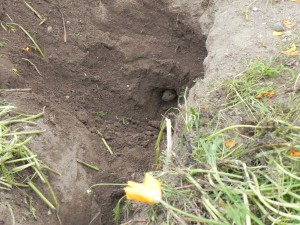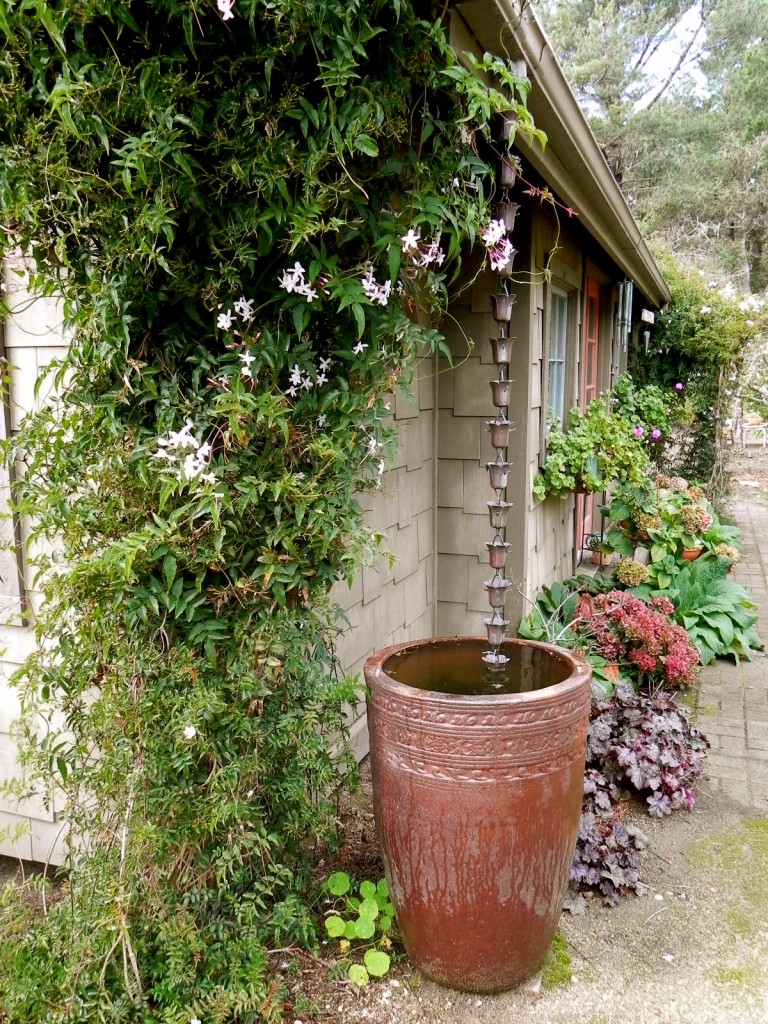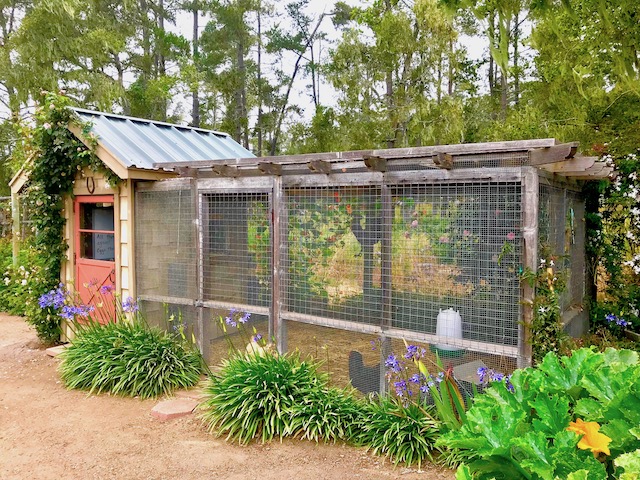
A colony of pocket gophers has set up residence in our yard, and Maddie, the labradoodle decided to expose them. She dug a hole, five feet in length and two feet wide in the soft soil between the roses. The pretty California poppies went flying but she did her job; she let us know that gophers had invaded our garden and we must get off our duffs and get to work to rid ourselves of these pests.
As soon as the soil dampens with winter rain, gophers become active. You will know they arrive when you find piles of earth in your beloved beds. These burrowing rodents are called “pocket gophers” because of their large external cheek pouches used for carrying food and nesting materials. They have powerful forequarters, large claws on their front paws, short fur, small eyes, and sensitive facial whiskers for maneuvering in close, dark quarters. Their lips, which close behind four large incisor teeth, keep dirt out of their mouths when using teeth for digging. Practical I’m sure, but hard to visualize!
We’ve had both moles and gophers this year. If you aren’t sure of the difference, see the post I wrote a couple of years ago. The smaller moles burrow close to the surface of the earth. They do not eat plants but dine on grubs and earthworms just below the surface. While they can disrupt newly planted annuals, they are far less harmful to your plants than the notorious pocket gopher. A little tolerance of this smaller cousin is encouraged.
The story goes that the “bull” gopher (a male gopher of breeding age) stakes out his territory and creates a maze of tunnels that he hopes will attract females seeking the “good life”. Sex always makes a story more interesting. If all goes well for the bull, the area is soon populated with young. Perhaps this maze is what Maddie found in her digging.

Gophers feed on a variety of plants using their sense of smell to locate food. Most folks, who’ve gardened for any length of time, will have a horror story to tell of watching a plant slowly being pulled underground if front of their eyes. A few years ago I observed a six-foot hollyhock list slowly to the side until it lay prone; its roots devoured by a subterranean pest. I found a prized seven-foot butterfly bush lying wilted and prostrate on the earth. The trunk appeared to have been eaten by a beaver. My guess is the culprit was a gopher who had left his run and “taken down” the shrub at ground level. I cut some of its branches and made some nice plants with the cuttings that still live in my garden today.

My husband uses a metal trap, called a Macabee, to keep down the gopher population. The trap requires brute strength to set. Then there is the problem of removing the dead gopher after it has been squeezed between the “pinchers”. I have neither the hand strength nor the stomach for this type of entrapment. We’ve also used the “Black Box” trap which is easier on the hands. In areas where the dog and chickens are excluded, I use the sissy method of gopher annihilation. I insert pellets of poison using a probe that puts it directly into the burrows. One must be extremely careful that none of the poison is spilled on the ground where birds can ingest it or pets come into contact with it. As I was taking pictures of the excavation and traps this morning, that little gopher had the nerve to stick her head out of the hole and look at me. The audacity!

There is no easy solution to the gopher problem. Some people in the area plant new plants in wire baskets. I’ve done this with expensive new plants that I think are vulnerable and it seems to work until the plant is mature and doesn’t need root protection.
Our property adjoins open space on one side and a vacant lot on the other. I’m realistic enough to know that we will have to deal with these underground critters one on one, and, at best, keep them under control. As for Maddie, the Australian Labradoodle, a little more training is in order.



I feel for you! I could have written this post as I’ve have experienced it all: a Doberman who dug after gophers so that parts of the yard resembled WWI trenches, basil plants disappearing underground before my eyes, tomato plants wilting overnight because the roots were devoured.
Our solutions are the same: traps (Gophinator) and probe & pellets with an anti-coagulant. For our vegetables and berries we use wine barrels and raised beds lined them with 1/4″ hardware cloth. For years we lived and let live but I think the gophers may have killed our wonderful old fig tree which other creatures (birds and people) depended upon for food and shade. So it’s zero-tolerance for the gophers.
I can’t stand gophers, one of my biggest fears for my garden. When we first moved in, there were a few that just kept popping up. We hired a company to come and capture the gophers, and haven’t had a problem since.
I wonder whether they trapped them or baited them. I would love to think that we could “rid” our garden of gophers but we have open space on both sides. Just when we think we have solved the problem in our half-acre, another gopher family moves in.
Hello,
I am working on an educational video for Southeast Asian farmers in Northern Calinfornia. I came across your “Old Macabee Traps need to be put in tunnels” and I would like to ask for a permission to use it on the video. Please let me know if this is possilble. Thank you and I look forward to hear from you soon
Kao…You have my permission to use the photo “Old Macabee Traps need to be put in tunnels”. Thank you for asking. Good luck on your video. Hope it is helpful to all who seek to keep the gopher population down.
Lee
This is great. Thank you so much Lee.
Kao